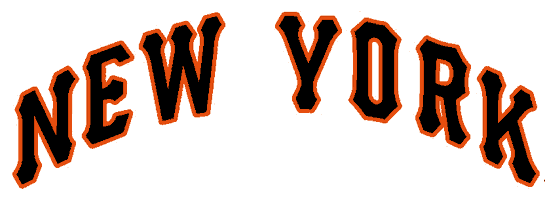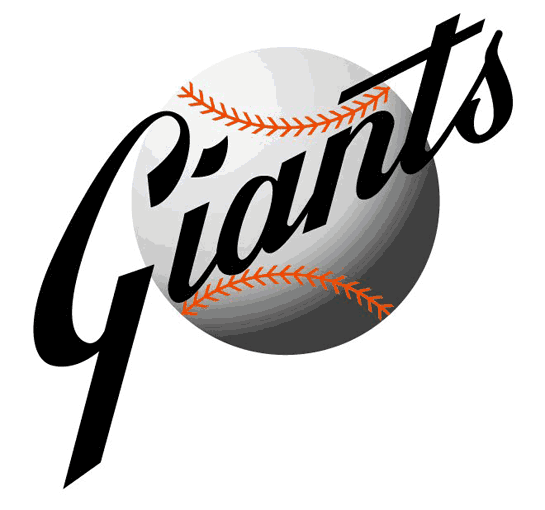
143 Seasons of the San Francisco Giants
World Series
Champions
National League
Pennants
Western Division Titles
1905 1954
1921 2010
1922 2012
1933 2014

1888 1924
1889 1933
1904 1936
1905 1937
1911 1951
1912 1954
1913 1962
1917 1989
1921 2002
1922 2010
1923 2012
2014
1971 2000
1987 2003
1989 2010
1997 2012
2021
National League Wild Card
2002
2014
2016
At the National League's owners meeting in 1882, New Yorkers John Day and Jim Mutrie, owners of a minor league NY club, were invited to enter a new franchise into the NL, which was ready to drop its Worcester and Troy clubs, for 1883. Rather than simply elevating their existing club to Major League status, the league desired they form a new club, stocked with the best players from the minor league team. Initially called the Gothams (and, apparently, occasionally the Maroons), in 1885 Mutrie, then the manager, stormed into the clubhouse after a particularly satisfying win over the Phillies and exclaimed "My big fellows, my giants!". The story goes that from then on the club was known as the Giants, although research suggests that at least one New York paper had begun calling them by that name slightly earlier. Either way, the name stuck.
The team won the "World Series", played against the American Association's champions, in 1888 and 1889 behind performances by future Hall of Fame pitchers Tim Keefe and Mickey Welch. After this, they settled into a period of mediocrity until a young Christy Mathewson came into his own and new manager John McGraw took the reigns in 1902. Over the next 30 years, the club won 10 NL pennants, but only 3 World Series (they might have had another, but in 1904 McGraw and owner John Brush refused to play the AL champion Red Sox because of business and personal rivalries). During this era the club took up full-time residency at Manhattan's Polo Grounds, perhaps the oddest stadium any MLB team has ever called home.
After McGraw departed in 1932, the club had some initial success (1 title, 3 pennants in the 1930s) but after that, sub-.500 finishes were the norm in the 1940s. In 1951, they tied the Dodgers in the standings at the end of the season, prompting a best-of-3 playoff series, and setting the stage for Bobby Thomson's game- and pennant-winning HR in the 9th inning of game 3. Waiting on deck at the time was a youngster named Willie Mays, who would lead the Giants to victory in the 1954 World Series and become, with Mickey Mantle, an icon of baseball over the course of the next 20 years.
In 1957, the Dodgers were considering a move to the west coast but could not obtain approval to do so unless another team also moved. Giant's owner Horace Stoneham, already looking to exit the crumbling Polo Grounds and possibly leave the city entirely, saw the lure of virgin baseball territory and a completely untapped fan base. Thus, in 1958 the Giants moved to San Francisco, ending an era in New York but starting a new tradition in California.
The story of the Giants' first 50 years by the Bay is one of also-rans and near misses. There were stars (Willie Mays, Orlando Cepeda, Willie McCovey, Gaylord Perry, Juan Marichal, Will Clark, Barry Bonds) and occasional success (pennants in 1962, 1989 and 2002 ) but there were also a heck of a lot of 2nd and 3rd place finishes, a good number worse than that, and many nights spent by fans in cold, dreary Candlestick Park watching the Giants play out the string. Then, as in an earlier era, fortunes changed after a new manager arrived. In 2010, only 4 years after Bruce Bochy took over, the club won its first championship since 1954. Then they won another in 2012. And then another in 2014. Bochy, Tim Lincecum , Madison Bumgarner, Buster Posey and others presided over a golden era in Giants history, giving fans in San Francisco a taste of what it was like for fans in Manhattan nearly 100 years prior.
The main purpose of this page is to illustrate those players, managers and coaches who have been the most prominent in the franchise's history. Links below will take you to galleries highlighting each, by position. Generally, an individual is included if he spent at least 2 full seasons (consecutive or cumulative) as a starter, relief pitcher, closer or manager. For coaches, I've generally used 5 years of service as the bar. None of this is scientific, though, so there are exceptions. Where possible and practical, I used pictures of actual baseball cards because that it is the medium through which I, and I suppose many others, first discovered the game. Where necessary, I designed my own images. Images of actual baseball cards were obtained at the Card Cyber Museum, and for my own designs I used photos found at host of different sites, but none moreso than the wonderful forum at Out of the Park Developments.
I claim no rights to, or ownership of, any of the photographic images I've used on these pages. You are welcome to use them yourself. All I ask is that that if you use any of my personal creations, you give credit to this site.
Cy Young Award
Winners
1967 - Mike McCormick
2008 - Tim Lincecum
2009 - Tim Lincecum
Rookies of the Year
1951 - Willie Mays
1958 - Orlando Cepeda
1959 - Willie McCovey
1973 - Gary Matthews
1975 - John Montefusco
2010 - Buster Posey
MVP Award
Winners
1912 - Larry Doyle
1933 - Carl Hubbell
1936 - Carl Hubbell
1954 - Willie Mays
1965 - Willie Mays
1969 - Willie McCovey
1989 - Kevin Mitchell
1993 - Barry Bonds
2000 - Jeff Kent
2001 - Barry Bonds
2002 - Barry Bonds
2003 - Barry Bonds
2004 - Barry Bonds
2012 - Buster Posey
Managers of the Year
1993 - Dusty Baker
1997 - Dusty Baker
2000 - Dusty Baker
2021 - Gabe Kapler

The original Polo Grounds - home of the Giants from 1883 through 1889. That year, the city was expanding its street grid system further north from Central Park, and mid-year the club was forced to play a number of games on Staten Island and in Jersey City, before occupying a new Polo Grounds, constructed north of their old site.
In 1889 and 1890, the team played in what has become known as the Polo Grounds II - a park located on acreage owned by the Coogan estate on the upper east side of Manhattan. In the photo at right, the outfield of yet another new ballpark can be seen in the distance.


That new ballpark? Polo Grounds III, but simply the Polo Grounds the hearts and minds of New York baseball fans forever more. Situated in bottomlands along the Hudson, beneath a cliff called Coogan's Bluff, the park went through several upgrades and even survived a fire in 1911.


For much of its history the Polo Grounds had short distances to the foul poles - 277 in left and 258 in right - but center field was a desert where home runs went to die measuring between 483 and 505 feet deep at various times.
For many years, fans not wanting to buy a ticket could avail themselves of a unique view of the game and the park from high atop Coogan's Bluff.

In 1958 and 1959, the Giants played in Seals Stadium, former home of the Pacific Coast League's San Francisco Seals.


Three views of Candlestick Park, in various stages of expansion/renovation, home of the Giants from 1960 through 1999. Located south of downtown right off the Bay, it could be brutally windy and cold; not the best place to watch a baseball game.


Oracle Park (nee Pac Bell Park, nee SBC Park, nee AT&T Park), the Giants' home since 2000.



NOTE: Dates are the individual's total years with the club, and not necessarily only the years they were most prominent.
MIckey Welch (l) and Tim Keefe (r), just two of the club's 19th century Hall of Famers, led the team to pennants in 1888 and 1889.


Manager John McGraw (l) and pitcher Christy Mathewson (r), two of the most unlikely partners for two decades at the beginning of the 20th century - McGraw, the profane, turbulent veteran of the equally famous and infamous 1890s Baltimore Orioles teams, and Mathewson, the polite, clean-cut "Christian Gentleman" - together they produced 5 pennants in New York from 1904-1913.

October 3, 1951: "The Giants win the pennant! The Giants win the pennant! The Giants win the pennant!"
Mel Ott - the great right fielder who hit 511 home runs using his trademark right leg lift - led the team from the mid-20s through the mid-40s.








Waiting on deck when Bobby Thomson hit his "shot heard 'round the world" was a kid from Alabama named Willie Mays. For the next two decades, The Say Hey Kid would become arguably the greatest player the game has ever seen. He remains forever ensconced in sepia along with Mickey Mantle and Duke Snider as emblems of the game's golden age when 3 New York clubs vied for the title each year.

In the late 1980s, Will Clark helped bring the Giants two division titles and a pennant. They lost him to free-agency in 1992, and fans would need to wait a while longer for the ultimate prize.
Barry Bonds - a Frankenstein's monster created from steroids, ego and overall unpleasantness.

Led by manager Bruce Bochy, pitcher Madison Bumgarner and catcher Buster Posey, the Giants experienced a period of dominance in the early 2010s which reminded fans of earlier years - 3 World Series titles in 5 seasons, from 2010-2014.




.png)
Giants No-Hitters:
July 31, 1891 - Amos Rusie, 6-0 over Brooklyn
July 15, 1901 - Christy Mathewson, 5-0 over St. Louis
June 13, 1905 - Christy Mathewson, 1-0 over Chicago
July 4, 1908 - Hooks Wiltse, 1-0 over Philadelphia
September 6, 1912 - Jeff Tesreau, 3-0 over Philadelphia
April 15, 1915 - Rube Marquard, 2-0 over Brooklyn
May 7, 1922 - Jesse Barnes, 6-0 over Philadelphia
May 8, 1929 - Carl Hubbell, 11-0 over Pittsburgh
June 15, 1963 - Juan Marichal, 1-0 over Houston
September 17, 1968 - Gaylord Perry, 1-0 over St. Louis
August 24, 1975 - Ed Halicki, 6-0 over New York
September 29, 1976 - John Montefusco, 9-0 over Atlanta
July 10, 2009 - Jonathan Sanchez, 8-0 over San Diego
June 13, 2012 - Matt Cain, 10-0 over Houston (perfect game)
July 13, 2013 - Tim Lincecum, 9-0 over San Diego
June 25, 2014 - Tim Lincecum, 4-0 over San Diego
June 9, 2015 - Chris Heston, 5-0 over New York
August 2, 2024 - Blake Snell, 3-0 over Cincinnati
Visit my 1978 Giants page
Links to other team history pages